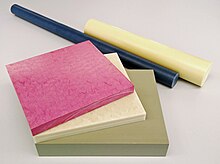Semi-finished plastic products
Plastic semi-finished products are semi-finished products made from standard plastics , technical or high-performance plastics that enable components to be manufactured economically. In principle, a semi-finished plastic product is a " profile (plate, tube, rod) generated by continuous forming, especially by extrusion , which is [...] further processed".
Semi-finished plastic products are suitable for the production of prototypes , individual components, but also for small to large product series. The user has a high degree of design freedom and can use numerous different plastic materials, each with specific technical properties.
Delimitation and characteristics
From an industrial point of view, semi-finished products are semi -finished plastic products between the plastic granulate or the plastic melt and the molded or finished parts, which are available in a specific shape and with fixed dimensions. Like metal semi-finished products , plastic semi -finished products can be further processed into a finished workpiece or component and thus easily meet individual requirements. Depending on the material, semi-finished plastic products have special chemical, electrical and mechanical material properties such as media resistance. By adding additives during compounding , the properties of engineering plastics can also be improved and adjusted to the needs of the respective application. This admixture creates materials with different properties that make semi-finished plastic products usable in a variety of ways. Especially for demanding applications such as For example, in the case of moving components, semi-finished products made of tribologically optimized plastics can be used to increase the service life of the components and to ensure that a machine or system operates largely maintenance-free. In addition, when using semi-finished plastic products with incorporated lubricants, additional lubricants such as oils and greases can be dispensed with, so that costs and environmental pollution can be reduced.
Manufacturing processes and forms
Semi-finished plastic products are manufactured by extrusion , compression (compression molding) or calendering . In most cases, standardized preliminary products are used, which are mixed into plastic compounds in various work processes. Plastic semi-finished products are available in various forms, similar to metals. Their names can differ depending on the manufacturer. In general, the following names and geometries are used:
Foils / sheets
“Films and sheets are flexible, flat products that are usually supplied in roll form as wide sheets or sheets or as narrow strips. More rarely, foils or sheets are available in sections of certain dimensions. "
Panels / plates / blocks
Boards are also flat products, but they are thicker and therefore less flexible than foils. One speaks of a board with a rectangular format. Semi-finished plastic products with large cross-sectional dimensions that are manufactured in a cuboid shape are blocks.
Round bars / hollow bars / tubes / hoses
If the geometric cross-section corresponds to a circle, either a compact round or solid bar or a hollow bar with different wall thicknesses is available. If the wall thickness is very small, one can already speak of a pipe. A special case are hoses, which, in contrast to rigid tubes or rods, are soft and flexible.
Poles
Elongated semi-finished plastic products with a square or polygonal cross section are called rods.
Profiles
Plastic semi-finished products with a wide variety of geometries are subsumed under the term “profile”. It can therefore also appear as a collective term for the forms mentioned above. As with the bars, there is also the option of perforated hollow profiles in various wall thicknesses.
Machining methods
Various mechanical or manual processes can be used to finish semi-finished plastic products. A basic distinction must be made between machining (or cutting) and non-cutting (e.g. hot forming or joining by means of welding or gluing ) processing. " Machining is (as) the fastest and most economical way to manufacture precise components ". They are the best way to create individual shapes with great precision and tight tolerances. In detail, semi-finished plastic products can be further processed by turning , milling , drilling , sawing , planing , chasing or grinding . During the machining process, processing stresses can occur in the workpiece, which can lead to the distortion of the components. Intermediate tempering is used to reduce these stresses and the resulting consequences. In addition, external cooling should reduce the heat developing at the processing point in order to exclude material softening or decomposition.
Areas of application
Due to their easy formability and machinability, semi-finished plastic products are used in many ways in manufacturing technology. Because various polymer materials are available for the production of semi-finished products, plastic semi-finished products can be optimally tailored to the respective application and the manufacturing process. This is because the materials can be optimized for certain properties such as wear resistance, freedom from maintenance, corrosion or chemical resistance, resistance to high temperatures or protection against external influences and contamination. All in all, semi-finished plastic products offer a wide range of possible uses. They are therefore used in various industries, including a. in automotive and mechanical engineering, in the food and packaging industry, through to particularly sensitive applications such as clean rooms in medical technology.
Web links
- Brochure: Semi-finished products made from high-performance polymers , igus GmbH
- Brochure: Overview of semi-finished products , Röchling Engineering Plastics SE & Co. KG
Individual evidence
- ^ Adolf Franck: Kunststoff-Kompendium, 2011, p. 456
- ↑ Marlene Doobe (Ed.): Kunststoffe Successful Gluing, 2017, p. 6
- ↑ Brochure: Semi-finished products made from high-performance polymers , igus GmbH, p. 4f
- ^ Sven Engelmann: Production of Semifinished Products, Extrusion, and Coextrusion; in: Advanced Thermoforming, 2012, p. 12
- ↑ Knippers / Cremers / Gabler / Lienhard: Atlas Kunststoffe + Membrane, 2010, p. 68
- ↑ Bozena Arnold: Material Technology for Industrial Engineers, 2013, p. 211
- ↑ Schwarz / Ebeling / Richter (eds.): Kunststoffkunde, 2015, p. 62
- ↑ Brochure: Machining recommendations for semi-finished products made of engineering plastics , Ensinger GmbH, p. 7
- ↑ Brochure: Semi-finished products made from high-performance polymers , igus GmbH, p. 17



